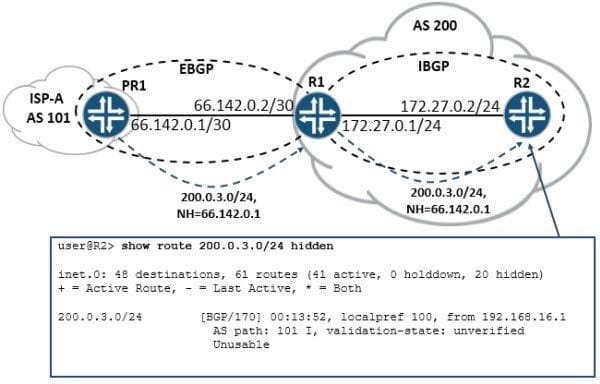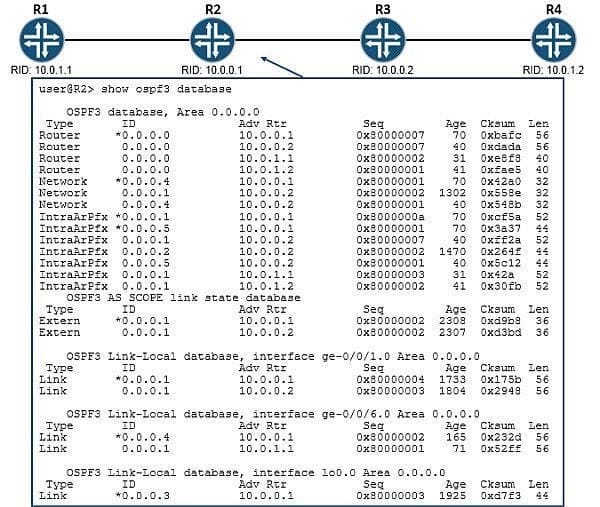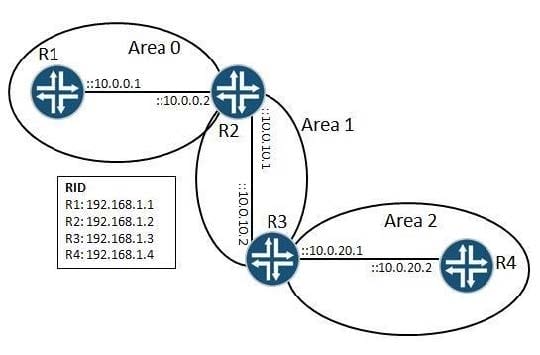Exam Details
Exam Code
:JN0-643Exam Name
:Enterprise Routing and Switching, Professional (JNCIP-ENT)Certification
:Juniper CertificationsVendor
:JuniperTotal Questions
:287 Q&AsLast Updated
:Mar 24, 2025
Juniper Juniper Certifications JN0-643 Questions & Answers
-
Question 261:
-- Exhibit

-- Exhibit -
Click the Exhibit button.
ISP-A is advertising the 200.0.3.0/24 route to R1. R1 is advertising this BGP route to R2 but the route is hidden on R2.
Referring to the exhibit, which statement is correct about the 200.0.3.0/24 route?
A. The route is unusable because the next hop is not reachable from R2.
B. The route is unusable because it has not been verified.
C. The route is hidden because R1 is changing the next hop to 192.168.16.1.
D. The route is hidden because R2 has a more preferred route.
-
Question 262:
-- Exhibit

-- Exhibit -Click the Exhibit button.
Referring to the exhibit, you are asked to verify certain routing information within your OSPFv3 routing domain. You must review the prefixes learned from R3.
Which two LSA types from the output shown in the exhibit must be reviewed? (Choose two.)
A. the Router LSAs from RID 10.0.0.2
B. the Extern LSAs from RID 10.0.0.2
C. the InterArPfx LSAs from RID 10.0.0.2
D. the Network LSAs from RID 10.0.0.2
-
Question 263:
-- Exhibit -- Exhibit -

Click the Exhibit button.
You are asked to connect Area 2 to the backbone.
Which configuration would be required on R3?
A. [edit protocols ospf3] user@R3# show area 0.0.0.0 { virtual-link neighbor-id 10.0.10.1 transit-area 0.0.0.1; interface ge-0/0/5.0; }
B. [edit protocols ospf] user@R3# show area 0.0.0.0 { virtual-link neighbor-id 192.168.1.2 transit-area 0.0.0.1; interface ge-0/0/5.0 { interface-type p2p; } }
C. [edit protocols ospf3] user@R3# show area 0.0.0.0 { virtual-link neighbor-id 192.168.1.2 transit-area 0.0.0.1; interface ge-0/0/5.0; }
D. [edit protocols ospf3] user@R3# show area 0.0.0.1 { virtual-link neighbor-id 192.168.1.2 transit-area 0.0.0.1; interface ge-0/0/5.0; }
-
Question 264:
-- Exhibit -[edit protocols ospf]
user@area-1-abr# show
area 0.0.0.1 {
nssa {
default-lsa {
default-metric 10;
metric-type 2;
type-7;
}
no-summaries;
}
interface so-0/1/1.0;
}
-- Exhibit -
Click the Exhibit button.
Referring to the exhibit, which statement is true?
A. The ABR will generate a Type 3 summary default route into the NSSA.
B. The ASBR will generate a Type 7 default route into the NSSA.
C. The type-7 parameter allows interoperability with newer versions of the Junos OS.
D. The only LSA types allowed into the area are Type 1, Type 2, Type 3, and Type 7.
-
Question 265:
-- Exhibit

-- Exhibit -Click the Exhibit button.
Referring to the exhibit, you are asked to prevent the 184.16.1.0/24 route from entering the backbone.
Which configuration statements would accomplish the task?
A. On router R1, issue the set protocols ospf area 3 nssa area-range 184.16.1.0/24 restrict command.
B. On router R3, issue the set protocols ospf area 0 area-range 184.16.1.0/24 restrict command.
C. On router R3, issue the set protocols ospf area 3 area-range 184.16.1.0/24 restrict command.
D. On router R3, issue the set protocols ospf area 3 nssa area-range 184.16.1.0/24 restrict command.
-
Question 266:
-- Exhibit -[edit protocols ospf]
user@R2# show
area 0.0.0.3 {
stub default-metric 10 no-summaries;
interface ge-0/1/1.0;
}
-- Exhibit -
Click the Exhibit button.
Referring to the output in the exhibit, which statement is true?
A. R2 is an ABR and will send a Type 7 LSA 0/0 route down into the nonbackbone area.
B. R2 is an ABR and will send a Type 3 LSA 0/0 route down into the nonbackbone area.
C. R2 will not send a Type 3 LSA 0/0 route into the nonbackbone area.
D. R2 will add a metric cost of 10 to the existing metric of a 0/0 route it receives from the backbone area and then send it into the nonbackbone area in a Type 5 LSA.
-
Question 267:
-- Exhibit -user@router> show ospf route Topology default Route Table: Prefix Path Route NH Metric NextHop Nexthop Type Type Type Interface Address/LSP 192.168.1.0/24 Intra Network IP 10 ge-0/0/1.0 -- Exhibit -
Click the Exhibit button.
Which two configurations result in the output shown in the exhibit? (Choose two.)
A. [edit protocols ospf] user@router# show reference-bandwidth 10g; area 0.0.0.0 { interface ge-0/0/1.0; }
B. [edit protocols ospf] user@router# show reference-bandwidth 1g; area 0.0.0.0 { interface ge-0/0/1.0; }
C. [edit protocols ospf] user@router# show reference-bandwidth 1m; area 0.0.0.0 { interface ge-0/0/1.0 { metric 10; } }
D. [edit protocols ospf] user@router# show reference-bandwidth 100m; area 0.0.0.0 { interface ge-0/0/1.0; }
-
Question 268:
-- Exhibit -user@router> show log ospf Sep 19 00:22:13.420315 OSPF packet ignoreD. MTU mismatch from 11.0.0.2 on intf ge-0/0/2.0 area 0.0.0.0 Sep 19 00:22:14.475671 OSPF periodic xmit from 14.0.0.1 to 224.0.0.5 (IFL 75 area 0.0.0.0) Sep 19 00:22:14.855490 OSPF periodic xmit from 12.0.0.1 to 224.0.0.5 (IFL 84 area 0.0.0.0) Sep 19 00:22:14.857304 OSPF packet ignoreD. no matching interface from 12.0.0.1, IFL 85 Sep 19 00:22:17.386726 OSPF packet ignoreD. MTU mismatch from 11.0.0.2 on intf ge-0/0/2.0 area 0.0.0.0 Sep 19 00:22:20.855690 OSPF packet ignoreD. subnet mismatch from 10.0.0.2 on intf ge-0/0/1.0 area 0.0.0.0 Sep 19 00:22:20.856108 OSPF rcvd Hello 10.0.0.2 -> 224.0.0.5 (ge-0/0/1.0 IFL 75 area 0.0.0.0) Sep 19 00:22:20.856177 Version 2, length 44, ID 10.0.0.2, area 0.0.0.0 Sep 19 00:22:20.856229 checksum 0x0, authtype 0 Sep 19 00:22:20.856299 mask 255.255.255.252, hello_ivl 10, opts 0x12, prio 128 Sep 19 00:22:20.856352 dead_ivl 40, DR 0.0.0.0, BDR 0.0.0.0 Sep 19 00:22:21.752438 OSPF packet ignoreD. MTU mismatch from 11.0.0.2 on intf ge-0/0/2.0 area 0.0.0.0 Sep 19 00:22:22.013285 OSPF packet ignoreD. area mismatch (0.0.0.1) from 12.0.0.2 on intf ge- 0/0/4.0 area 0.0.0.0 Sep 19 00:22:22.013749 OSPF rcvd Hello 12.0.0.2 -> 224.0.0.5 (ge-0/0/4.0 IFL 84 area 0.0.0.0) Sep 19 00:22:22.013804 Version 2, length 44, ID 10.0.0.2, area 0.0.0.1 Sep 19 00:22:22.013890 checksum 0xd51e, authtype 0 Sep 19 00:22:22.013944 mask 255.255.255.252, hello_ivl 10, opts 0x12, prio 128 Sep 19 00:22:22.014012 dead_ivl 40, DR 12.0.0.2, BDR 0.0.0.0 Sep 19 00:22:22.016909 OSPF packet ignoreD. no matching interface from 12.0.0.2, IFL 85 Sep 19 00:22:22.434956 OSPF hello from 11.0.0.2 (IFL 83, area 0.0.0.0) absorbed Sep 19 00:22:23.045916 OSPF periodic xmit from 12.0.0.1 to 224.0.0.5 (IFL 84 area 0.0.0.0) Sep 19 00:22:23.047959 OSPF packet ignoreD. no matching interface from 12.0.0.1, IFL 85 Sep 19 00:22:23.309957 OSPF periodic xmit from 11.0.0.1 to 224.0.0.5 (IFL 83 area 0.0.0.0) Sep 19 00:22:23.528614 OSPF periodic xmit from 14.0.0.1 to 224.0.0.5 (IFL 75 area 0.0.0.0) Sep 19 00:22:25.772835 OSPF packet ignoreD. MTU mismatch from 11.0.0.2 on intf ge-0/0/2.0 area 0.0.0.0 Sep 19 00:22:29.950015 OSPF hello from 11.0.0.2 (IFL 83, area 0.0.0.0) absorbed Sep 19 00:22:30.622112 OSPF packet ignoreD. MTU mismatch from 11.0.0.2 on intf ge-0/0/2.0 area 0.0.0.0 Sep 19 00:22:30.713279 OSPF packet ignoreD. subnet mismatch from 10.0.0.2 on intf ge-0/0/1.0 area 0.0.0.0 Sep 19 00:22:30.713432 OSPF rcvd Hello 10.0.0.2 -> 224.0.0.5 (ge-0/0/1.0 IFL 75 area 0.0.0.0) Sep 19 00:22:30.713503 Version 2, length 44, ID 10.0.0.2, area 0.0.0.0 Sep 19 00:22:30.713553 checksum 0x0, authtype 0 Sep 19 00:22:30.713622 mask 255.255.255.252, hello_ivl 10, opts 0x12, prio 128 Sep 19 00:22:30.713677 dead_ivl 40, DR 0.0.0.0, BDR 0.0.0.0 -- Exhibit -Click the Exhibit button.
Referring to the exhibit, what is preventing the OSPF adjacency on interface ge-0/0/4 from forming?
A. area mismatch
B. subnet mismatch
C. MTU mismatch
D. authentication mismatch
-
Question 269:
-- Exhibit -user@router> show ospf database network extensive
OSPF link state database, area 0.0.0.1
Type ID Adv Rtr Seq Age Opt Cksum Len Network 10.222.1.1 192.168.20.1 0x80000002 813 0x2 0x 32 mask 255.255.255.0 attached router 192.168.20.1 attached router 192.168.40.1 Aging timer 00:46:27 Installed 00:13:32 ago, expires in 00:46:27, sent 1w5d 01:07:09 ago
-- Exhibit -
Click the Exhibit button.
Referring to the exhibit, which statement is true regarding the OSPF network LSA?
A. The ID field value shows the router ID of the advertising router.
B. The ID field is the local interface IP address from which the LSA will be advertised.
C. The options field indicates this is a Type 2 LSA.
D. The output shows that 192.168.20.1 is the designated router.
-
Question 270:
Which statement is true regarding the SPF algorithm?
A. The SPF algorithm is run on a per-domain basis.
B. If you apply an import policy to OSPF, it keeps LSAs from being flooded, and the SPF calculation can be affected.
C. There are two databases used in the calculation, the link-state database and the tree database.
D. The SPF calculation is run on a per-area basis on each router.
Related Exams:
JN0-102
Internet Associate, Junos(JNCIA-Junos)JN0-104
Junos, Associate (JNCIA-Junos)JN0-105
Junos, Associate (JNCIA-Junos)JN0-1101
Juniper Networks Certified Design Associate (JNCDA)JN0-130
Juniper networks Certified internet specialist.e(jncis-e)JN0-1301
Data Center Design, Specialist (JNCDS-DC)JN0-1302
Data Center Design Specialist (JNCDS-DC)JN0-1331
Security Design, Specialist (JNCDS-SEC)JN0-1332
Security Design, Specialist (JNCDS-SEC)JN0-1361
Service Provider Design Specialist (JNCDS-SP)
Tips on How to Prepare for the Exams
Nowadays, the certification exams become more and more important and required by more and more enterprises when applying for a job. But how to prepare for the exam effectively? How to prepare for the exam in a short time with less efforts? How to get a ideal result and how to find the most reliable resources? Here on Vcedump.com, you will find all the answers. Vcedump.com provide not only Juniper exam questions, answers and explanations but also complete assistance on your exam preparation and certification application. If you are confused on your JN0-643 exam preparations and Juniper certification application, do not hesitate to visit our Vcedump.com to find your solutions here.